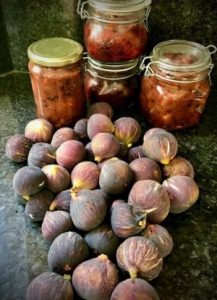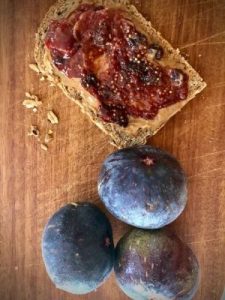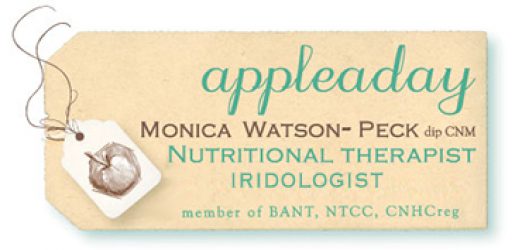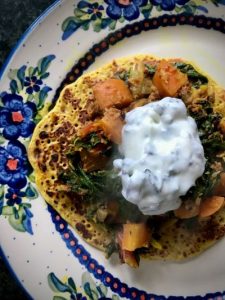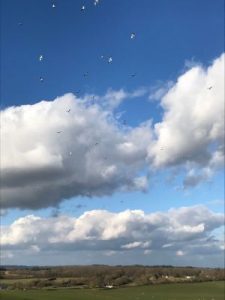Last week we packed up the car, put on our masks and I took a very deep breath of courage. A road trip across Europe was the last thing on my mind, I was still stuck in Downing’s street ‘Stay home’ slogan even though UK had moved on from there.
Travel was happening, flights were flying, but government recommendations were once again wobbling, erring on the side of caution after some viral clusters up north and spikes in parts of Spain. I was quite happy staying in our Dorset cocoon, thank you kindly.
However I’m married to a braver human bean who was chomping at the bit to get out to the olive grove, to lop and clear and feed our trees for that wannahave opulent harvest. Also to deal with any wildlife that had moved into the house, and yes, to swim in the Ionian and enjoy some summer heat.
He told me we could do the drive in three days, just had to exercise caution and common sense and keep washing our hands.
I wasn’t so sure, but the choices didn’t look good. Fly out and join him when the virus had calmed down? Well, planes were definitely not on my to-do list (yet!), and Covid-19 wasn’t showing any signs of exhaustion.
Husband Braveheart then assured me we didn’t have to book anything until the last minute. He knew me well. It gave me wriggle room to wait and see if the dreaded second spike would lock us down; time to check online if there were problems crossing borders.
Silly, of course, since problems could arise from day to day, minute by minute, but crucially it gave me time to get used to the idea and supplement my faith and wobbling courage with mega doses of brave thoughts.
Fear can really mess around with your mind. That’s what this road trip has shown me. Also, that the English, French, Italians and Greeks all look the same in masks (but tomatoes in each of these countries look quite different 🙂
We headed off on a Tuesday just after dawn, passing the most breathtaking gossamer mist lying on the fields around our village; sheep floating on clouds. How I would’ve loved to have taken some pictures but I knew that a photo stop three minutes from home might be pushing my luck. We were now on a mission, moving forward at speed.
We drove past the edge of a low-cloud New Forest, then onto a mist-filled empty M3 followed by a not-so-misty M25 with morning traffic moving smoothly, which was a first. Needless to say we arrived at the Eurotunnel with oodles of time to spare, but no earlier trains were offered unless extra was paid. That wasn’t going to happen since we’d already paid considerably more than in the past.
So many cars were lined up at the terminal! Didn’t they know they shouldn’t be crossing borders or gallavanting off? That hesitant see-saw was STILL happening in my head even after we’d packed up the house and given three peeps baby-sitting rights to our house and tomato plants. Crazy, right? Fear had definitely set up home in my brain’s amygdala.
The first interesting Covid change I noticed was that only Starbucks was open in the Eurotunnel building. Leon’s restaurant and the other independant coffee/food outlet there were both shut, and that just about sums up how stupid some decisions have been in these times. No real coffee to be had for Braveheart and no delicious Leon nibbles for me.
Luckily I’d made enough sourdough rolls to last the week so we didn’t bother, but we did use the loos; signs everywhere were warning us that toilets on the train were off bounds.
People came in and out of the terminal, lined up for their Starbucks, but they weren’t the crowds I’d dreaded. Most of them were wearing masks and certainly all were keeping sensibly apart.
The border checked our passports and that was it. No taking of temperatures, no forms to fill out declaring we were Covid-free, although I could’ve sworn the month before, online forms had been requested; go figure.
Whisked from Folkestone to Calais in 30 minutes we found ourselves on the autoroute with a clear blue-sky above, and on both sides endless stands of ripening corn and dirt-brown fields where grains had been harvested. On the horizon I could make out vast stands of sunflowers, blooms long gone but still tall and leafy with blackened seed heads gently bowed to the ground. This was normally the low, flat landscape with sludge grey skies that would make me yawn into a neck-cricked car sleep. Today a shining scene took hold of my attention. Windows open, I breathed in holiday.
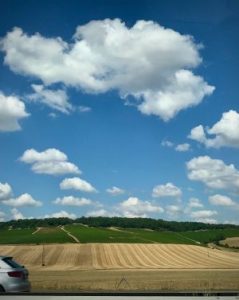
Before I go any further, and whilst in France, I have to mention the autoroutes here. Who can’t wax lyrical about them after the bump and polluted constriction of the M25? Why we can’t do the same in England is a mystery to me. Can anyone explain?
In addition, the highway service stations in France are also more like destinations than simply refuelling spots. Rows of shady trees, beds of tall swaying white gaura and cars separated by wide stretches of grass and picnic benches. Not the concrete car landscape on most of the British motorways with their boxed-in plantings and scattering of reluctant saplings trying their best. So, even with a stream of travellers arriving off the autoroute all the time, safe-distancing was easy. Enough space and trees and greenery to separate us all.
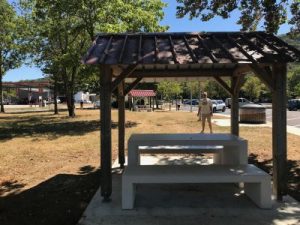
We covered 891 kilometres that first day, the longest drive day of all. We decided to bed down just outside Beaune, a beautiful medieval town in the centre of the Bourgogne wine region that we’d never seen before and hadn’t planned on seeing now – we were on our mission etc – but the evening we arrived something changed. We sat in the hotel gardens, trying the local wine and eating our sourdough sandwiches (the restaurant was closed), and as we watched guests soaking up the last of the sun and a family playing in the pool, a couple riding down the lane on bikes, I suddenly realised that we were watching people who were actually on holiday, not just passing through as quickly as possible. So the following day we woke up to the idea that a drive into town and a wander around would be just the thing. Braveheart’s mission could be put on hold for an hour.
Turned out to be three hours because Beaune may be small but it is really one of the prettiest towns. Very vigilant too, almost worryingly so. Masks were on indoors as well as out, with locals crossing the street when they saw us, hurrying along cobbled lanes armed with purpose and fresh baguettes.
When I look back, it was in Beaune where people seemed to be the most careful, taking ‘soyez prudent’ to a level that would disperse any fear of catching anything, not even a smile or a glance, which of course is another sorry downside of this distancing palaver and mask-wearing. Not seeing facial expressions and smiles and people not making eye contact.

At the end of our wander we watched a small street market being set up (of course there’d be a market, we’re in France!) This one was mainly selling trinkets but onetiny stall had a display of the most astonishing tomatoes which had nothing to do with the tomatoes in my veggie box back home, or the tiny firm buds of green cherry toms in our Dorset garden.
This Beaunian stall holder was selling heritage tomatoes in delightful small crates, denizens of the region I would’ve happily slipped into our car had there been room (sadly, like a time capsule, it was filled to the brim, ready for all countries, weathers and emergencies). Just seeing these tomatoes made me so inordinately happy. Look at them, aren’t they stunning!?
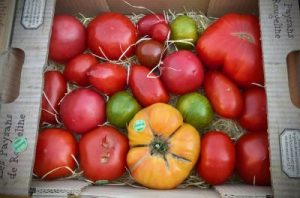
Leaving the town late morning we wound our way towards the foothills of the Alps and onwards to the chocolate-box mountains that would take us over the border to Italy.
Did it occur to us there might be long delays into the Mt Blanc tunnel?
When the road sign glittered silver bold type letters at us ‘Expect a wait of 90 minutes’, I was sure it was Covid-related, the testing I’d been expecting or at least something to do with checking forms and asking about our well-being.
But no, it was simply August, the main holiday month in France and Italy. With most people staying closer to home there were more cars on the road – not that we realised until we got stuck in the tunnel queue.
Motor off, windows down and another sourdough sarnie as we waited for all the vehicles to inch up the last hairpin. Snowcapped mountains above, a waterfall beside us, it was easy to take.
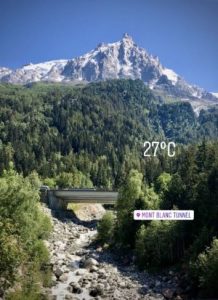
By early evening we reached Piacenza, a beautiful walled city in the Emilia Romagna region. We’d stayed here a few times before, loved the Palazzo Gotico and Piazza Cavalli, and the hotel which had coped so well with our groundhog days two years before when our old car broke down and we stayed on and on.
Sad, but no surprise to hear the hotel was running at 40% capacity. And the breakfast buffet the following morning was such a lonely experience, with us standing in a vast room at a distance to the buffet table, pointing to various foods whilst a young masked girl silently placed hot and cold bits on our plates. Cold scrambled eggs by the time we reached our table, not a culinary delight.
Emilia Romagna was one of the four regions in northern Italy worst hit by the pandemic back in March. The north was where Italy’s Covid-19 journey began. In April about 70% of positive virus cases were reportedly from Lombardi, Emilia Romagna, Veneto and Piemonte here in the north.
Contrary to what you might be thinking, knowing about my wobbly start, this Covid fact hadn’t concerned me in the least when I was doing our last minute overnight bookings before the trip. My brain must’ve been appeased by the fact that people here had been through hell and would be careful, they wouldn’t want it repeated.
We sat outside in the square, drank our beer and aperol spritze then moved to another outdoor restaurant for dinner at 8. Most tables were empty, too early for the locals but not for us. After 623 km, and with more dreary hours on the autostrada than we ha expected, we were exhausted and in need of a long sleep.
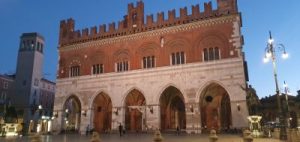
Day 3, the planned short drive (not) from Piacenza to Ancona. We were catching our Anek lines vessel at 1500hrs for the overnight crossing of the Adriatic, landing the following morn at 8 (not!) in Igoumenitsa, northern mainland Greece.
What we didn’t take into account was that Italy, too, had crazy early morning work traffic. Bumper to bumper for a couple of hours then some light reprieve for a few breaths before the turn-off to Ancona, with another slow crawl behind a stream of cars heading towards the port. Luckily those see-saw thoughts of mine had stopped – the ones silently questioning why peeps were travelling and not staying home. Fear had let go its white-knuckled grip as we waited in endless queues of traffic.
We’d talked about buying fresh food to take on board the boat since our sourdough sandwiches were long gone, and who knew what the ship’s restaurant would be like.
Following the huge check-in sign above the road, we parked and walked over to the terminal building where “Only car driver inside” handed over our precious declaration documents proving we were fit and symptom-free with no known Covid case contact (hooray, at last someone wanted to know!)
But with that we were checked into the system and unable to drive back to town to go food shopping. Once checked in we couldn’t ‘check out’!
There was only a lone portacabin cafe by the terminal building selling limp pizzas; that was it. So there was not much more for us to do than follow the signs to the expanse of boarding area, a concrete desert where hundreds of cars and trucks were already waiting in the midday heat.
Tucked on one side was a small white van that was selling food no one seemed to want. Just one lone customer sipping on an overly bright-orange sparkling something.
I don’t know if this lack of food outlets was Covid related or not, but what a missed opportunity, given the hundreds – thousands? – of trucks, cars and bikes waiting there for hours each day.
I walked over to check it out even though the bags of crisps, biscuits and fizzy drinks looked very unpromising. Disappointment bubbled up again that we’d missed out on a deli purchase in town.
But then I saw them over on the right. Through the glass display window I spied fresh rolls, ham…. and a pile of the juiciest red beef tomatoes, the only fresh veg I’d glimpsed since leaving Piacenza at crack of early. Another moment of tomato joy in a sandwich!
Just before separating to go on board (‘only drivers in the car, passengers walk’), we clocked that we’d covered another 380 km. We’d done the fastest zzzzzoom across Italy ever.
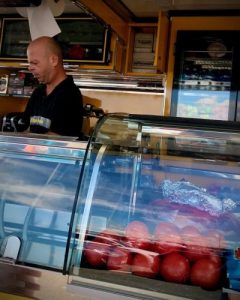
I could write a whole blog about the ship aka ferry crossing but I’ll spare you.
A quick list of impressions instead:
– All the crew wore small chin visors but most were cupped below the mouth looking more like some medical chin support.
– I never saw a bottle of hand sanitiser on board but there were plenty of soap dispensers in all the public toilets so that was something
– A crew waiter or waitress was quick to clear up the huge mess of edible debris that was sadly abandoned by mainly young peeps (sorry, but true) who were maybe travelling together, or maybe not
– Every hour or so an intercom voice announced how the vessel was ensuring masks were worn and distances kept, and that this was the reason why ‘Anek lines was keeping us safe.’ But…I never saw or heard any crew member telling us to wear masks and keep safe. Some travellers wore them when going into the cafe or wandering around the inside of the ship but I can’t say it was a masked sea journey. Half and half if I’m being kind.
– A big positive: it was easy to find secluded corners, quiet spaces to keep our distance. Or to stay in a cabin – if you had one, which we did. A super cozy one in fact with a large porthole window we’d never had before on these crossings. Normally a black hole cabin, but this time Braveheart had booked us a ‘Pure’ cabin (which does beg the question what the rest of them were).
– The tables in the self-serve restaurant couldn’t be distanced as they were bolted to the ground, but there were only a few people dining and they were all using common sense. We certainly enjoyed our Greek salads without strangers breathing all over them x

The following morn yet another shining day greeted us. What a sunny road trip we were having! However, our hearts sank when we realized the ship aka vessel aka ferry wasn’t going to be landing in Igoumenitsa by 8. We hadn’t even reached the first stop of Corfu and given we had another ferry to catch which was a 3 hour drive south we were aware of time passing.
It was s-l-o-w progress disembarking. Officials were checking documents and I have to admit I felt quite put out when we were told we had to leave our spot in the line of cars for the Covid testing (which I’d been waiting for all this time, but not now when we were about to miss connections!)
The chin-masked official pointed to a dead-end area in the distance, a normally forgotten, shabby corner of the port where around 20 cars were parked hugger-mugger. I could make out clusters of people and a line of sorts forming the way Italians and Greeks do it, not the British-like queues.
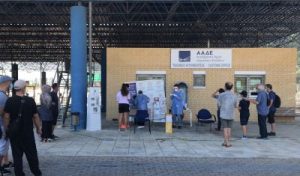
There were 2 ‘patient’ chairs and just 3 officials in PPE but, oh my word, they worked quicker than I could’ve ever imagined. I’m guessing they didn’t want to be in close contact for more than a minute with any of us viral foreigners. Results, they told us, would be texted to us in 24 hours IF positive.
Luckily we never got that text.
The drive south to Patras was easy, partly because we’d done it before but also due to the fact it was a new highway, thank goodness, which was more than equal to the French autoroutes. Breathtaking mountain scenery all the way, hardly any cars and the first spits of rain and grey skies, how funny, now we were in sunny Greece.
After Patras, there was the usual hair-raising 45 minute drive on the one-lane-pretending-to-be-three road to Killlini; this was the main port for ferries heading to the Ionian islands. We were speeding along with the others, dearly hoping we’d make our ferry connection.
Levante’s car ferry crossing turned out to be a totally different experience to the previous one. Yes, only a 1.5 hour journey but it was full of rules and hand sanitiser and an official keeping us a metre apart as passengers boarded.
Masks had to be worn at ALL times we were told. Inside, alternate tables and chairs had been cordoned off ensuring no one sat too close.
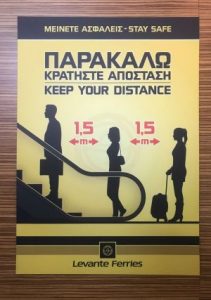
When I took off my mask to drink water, at our safely distanced table, I forgot to put it back on (ok,perhaps I forgot on purpose; suffocating in the heat). A young woman at the table closest to us reminded me loudly to put my mask back on.
Even out on deck, with plenty of space and fresh air and hardly anyone about, masks had to be worn, which I thought was a bit ott (and that should be enough to tell you that 4 days of crossing borders had sorted out the fearful amygdala of my brain).
99.9% of the people on board were from Greece, one chatty official explained when I asked why the speaker annoucements weren’t in their usual English.
He told me the announcer was telling us that Levante ferries were keeping us safe.
And indeed they were!
We landed in Kefalonia, in the town of Poros and only had a short drive to our olive grove house.
Somehow those 35 minutes felt longer than the hours we’d travelled each day, but they did give me pause to think about the miles covered, and to feel grateful for the sun and blue skies that had made it all so easy, showing us so many landscapes at their best. And also to take stock of just how empowering those four travel days had been. I suspect fear had flown out the window the minute I realized it wasn’t just in UK – or in our cocooned Dorset – that people were using common sense and trying to stay safe. All of us in this global mess together were doing our best.
Freshly picked tomatoes and chillis from our lovely neighbours awaited us, and a message from home that felt like a pat on the back, congratulating us on the journey.
They were definitely the best-tasting tomatoes I’d eaten.
Well…the best that day 🙂
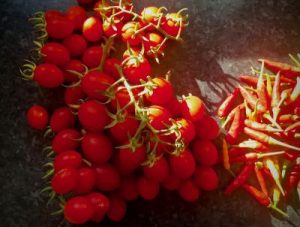
Stats:
Left Dorset 0550hrs 4th August, arrived Kefalonia 1700hrs 7th August.
Kilometres driven: 2272 km
Ferry Ancona-Igoumenitsa: 723 km (390 nautical miles)
Ferry Killini to Poros: 50 km.
Phew!
